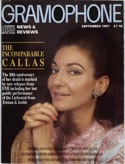Texte paru dans: / Appeared in: |
|
|
Outil de traduction (Très approximatif) |
|
|
Reviewer: Nicholas Anderson
The advent of the CD seems to have prompted a flurry of interest in the music of Andre Campra (1660-1744). How curious, since he does not even have an anniversary in the offing. Well, since I'll be dead and buried by the year 2044 let alone 2060, when such junketings could take place, I might as well make the most of this welcome, if modest, enthusiasm for his music. In point of fact much of it, both for the church and for the stage, is noteworthy and this Messe de Mort or Requiem Mass affords ample proof. Its date of composition is uncertain but, since the closing fugue is an elaboration of one which he had incorporated into his grand motet of 1723, De profundis, we might suppose it to have been composed sometime after that. Others, however, place the work earlier in Campra's life.
During the eighteenth century there were various permutations of the content of the Requiem Mass and in Campra's version there are certain omissions. There is no Dies irae, for instance, nor a Libera me. The Benediclus, too, is excluded, though this is also true of some of Charpentier's Masses . Campra's setting is, nevertheless, quite extended and falls into seven sections - Introit; Kyrie; Gradual Offertory; Sanctus; Agnus Dei and Post Communion. These sections are further subdivided variously into recits , dialogues, duos, trios and choruses. I have long found this work of great and, it would seem, enduring beauty. Campra was a gifted theatre composer and knew well how to handle the components of an elaborate sacred work in a colourful and dramatic manner. We find evidence of that, for example, in the Gradual, whose reiterated "non , non" etc. recalls a chorus in Act 3 of Charpentier's Médée, and in the throbbing bass of the Offertory opening. But it is the quiet intensity and the strongly contemplative character of Campra's Requiem which, perhaps, strike the profoundest note. It is, furthermore, a work of considerable individuality which stands out from among the greater number of sacred works of the "Grand Siècle".
This … recording from Harmonia Mundi is the third to have been released commercially. * The performance is attentive to points of style and has some particularly convincing solo singing, notably from two British artists , John Elwes and Stephen Varcoe. Varcoe's contribution I thought outstanding in the Sanctus but throughout the solo team is a strong one. As usual, the voices of La Chapelle Royale are pleasantly blended and clear in texture. The orchestra, too, make a strong contribution with several instances of effective woodwind playing. Compared with John Eliot Gardiner's Erato account of the same work , Herreweghe may well strike us as being a little cool, a little detached; it seems a small point but in the end, I think it is the crucial one for Gardiner introduces an intensity to his reading which is persuasive. The Monteverdi Choir always sound more fervent than that of La Chapelle Royale, but I feel that Gardiner also captures the pathos of Campra 's music to a greater extent than Herreweghe. In the end it is more a matter of personal taste than a question of choosing the better performance. Herreweghe does full musical justice to Campra's score but Gardiner succeeds better in stirring our passions. The new version is beautirully recorded and, as I say, eloquently performed. Herreweghe, incidentally, prefers a lower pitch of A = 392 whilst Gardiner opts for A =415.
|
|
|
|
|
|
Cliquez l'un ou l'autre
bouton pour découvrir bien d'autres critiques de CD |
|




